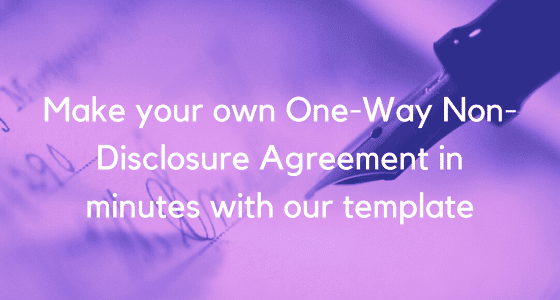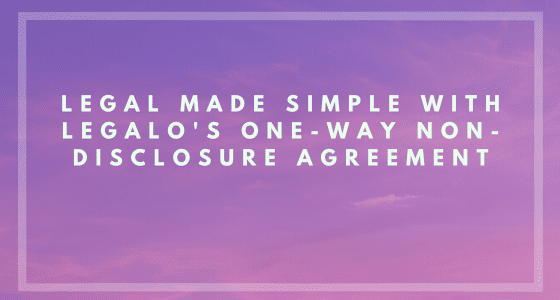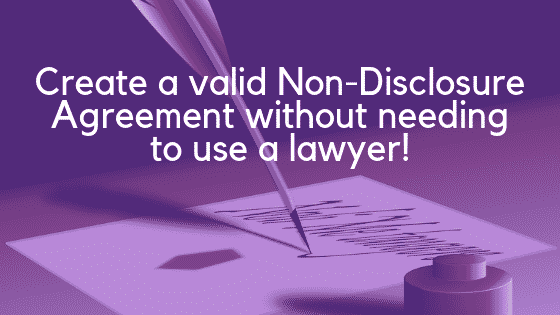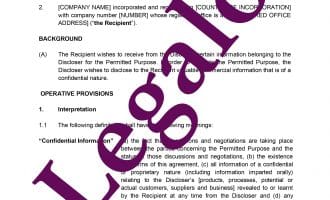One-Way Non-Disclosure Agreement
Our One-Way NDA Template:
- Drafting guide included
- Drafted by a UK solicitor
- Reliable protection for you
- Simple and quick to complete
- Protect your information!

How Does It Work?
-
1. Download
-
2. Edit
-
3. Print
-
4. Sign
A One-Way Non-Disclosure Agreement (NDA) is suitable for use when only one party will disclose confidential information. Typically this will be as part of a business discussion or during commercial negotiations.
If your business needs to disclose information confidentially, you should put in place an NDA. Do this before sharing the information. Use our one-way NDA for this purpose.
Why do you need a Non-Disclosure Agreement?
Whether you are just getting started or you are developing a new product, you want to protect your business ideas and other confidential information. UK copyright laws do not protect ideas, so if you want to make sure no-one steals your idea, you need to have them sign a one-way non-disclosure agreement before you share your ideas with them. You should also give this agreement to anyone making or designing prototypes for you.
How to Write a One-Way Non-Disclosure Agreement
We recommend using our one-way NDA template as your starting point. The template is suitable for any UK-based business engaging with another party in the UK or overseas. The template was drafted by our solicitor and co-founder David.
The document is quick and easy to complete. We include a detailed set of guidance notes with the document. They can be downloaded to guide you through writing the NDA. On average the drafting time required to write this NDA is about ten minutes. Yes, it’s that simple a document!
A free template is available from the Government’s website. You can find it here. However, the document that they provide is extremely short and not very comprehensive. It is better than nothing.
However, for a modest fee of £14.95 you can get our substantially more comprehensive one-way non-disclosure agreement template. By doing so, you can ensure robust legal protection for the important confidential information that you will share.
One-Way NDA v Mutual NDA
A one-way non-disclosure agreement protects only the information shared by one of the parties to the agreement. The agreement is ideal for use where it is clear from the outset that confidential information will be shared by just one party.
For example, a company engaging with a manufacturer for the manufacture of a new product that it is launching. Or a person, or company, discussing an invention they are looking to patent.
We are often asked: What’s the difference between a one-way NDA and a mutual NDA?
A mutual NDA (often referred to as a reciprocal NDA) protects the information shared by either party to the agreement. This type of NDA is preferable to use when:
- it is not clear that only one party will share confidential information; or
- both parties will exchange confidential information.
In some discussions the recipient of confidential information may prefer that a mutual NDA is signed, just in case they do share confidential information. A party receiving a mutual NDA is likely to be less suspicious of it. After all, the restrictions on use of shared information will apply equally to both parties.
When to Use a One-Way NDA
Use a one-way non-disclosure agreement whenever you are going to share confidential information with another party. As explained above if you expect the other party may also share confidential information with you, then consider a mutual NDA, instead of a one-way NDA. We offer a range of NDA templates.
As well as the standard one-way NDA template and the mutual NDA template, we also offer a very short-form NDA letter template. This can be ideal for use where you want to keep the contract to the absolute simplest form possible.
We also offer an abbreviated short-form simple NDA template. Use the simple template if you want to put something in place that is a little more comprehensive than a letter, but you do not want to put the other party off by sending them a detailed NDA agreement. This will depend on who the party is that you are dealing with, the level of their legal know-how and their overall commercial experience.
The basic text of the one-way non-disclosure agreement states that the information you are discussing is for a specific project. You can edit this to cover any future project if you expect to have ongoing dealings with the person or company.
People also call this agreement a one-way confidentiality agreement. Whatever name the document goes by, our template will protect your ideas and confidential information all the same. If you need more general information about NDAs, here’s what Wikipedia says about them.
Using our One-Way Non-Disclosure Agreement Template
We strive to provide great value for money. As we advise above, you can obtain a free one-way NDA template online. However, for the small fee payable, our template is a lot more detailed and provides better legal protection. For your peace of mind, the template has been drafted by an experienced solicitor.
You can purchase this agreement template here for far less than a high street solicitor would charge. In doing so, you won’t be compromising the legal protection offered by an NDA agreement, because our commercial solicitor drafted this document. So you can buy from us with confidence.
Also keep in mind that, as experienced solicitors, we have made sure that our one-way non-disclosure agreement template is not full of legal jargon that can be difficult to interpret. The template uses simple plain English. We expect it to take less than ten minutes to draft, with the help of our drafting guide.
If you need to add something in the agreement, our template is fully customisable. You will also be able to use the template as many times as you need to. You get a one-way NDA template for life! We also offer free updates to the template, as they become available, at no further charge.
Our one-way non-disclosure agreement will be easy for you to follow and, as we have said, includes a guide to help walk you through the process. For a example preview of the guide to our very similar one-way confidentiality agreement click on this link.
Keep in mind if you prefer a simpler or shorter form template, then you can use our non-disclosure letter template – click on the link. Alternatively, view the full range of non-disclosure agreement templates that we offer.
How to Sign Your NDA Agreement
Finally, once you have completed writing the one-way non-disclosure agreement using the template, you need to sign it. You can sign the completed document in ink or electronically.

FAQs on a One-way Non-disclosure agreement
Below, we’ve answered all of the top questions on this topic from the Internet.
What is a one-way non-disclosure agreement? What is a one-way NDA in practical law?
A one-way non-disclosure agreement is a legally binding contract that involves one party sharing confidential information with another party. The recipient of the information agrees not to disclose or utilise the information for unauthorised purposes. This agreement sets forth the responsibilities of the recipient to safeguard the confidentiality of the disclosed information. This agreement ensures the protection of sensitive data for the disclosing party, allowing them to securely collaborate or engage with another entity.
What is the difference between a 1 way and 2 way NDA?
A one-way non-disclosure agreement is when confidential information is shared from one party to another, with only one party revealing information. On the other hand, a two-way NDA, also called a mutual NDA, is when both parties exchange confidential information and are obligated to maintain its confidentiality.
Does a non-disclosure agreement go both ways?
You can categorise a non-disclosure agreement as either one-way or two-way. In a one-way NDA, only one party discloses confidential information, while in a two-way (or mutual) NDA, both parties exchange confidential information and the confidentiality obligations bind both parties. The decision on which type of NDA to use depends on factors such as the nature of the information they are sharing and the roles of the parties involved in the agreement.
What is the purpose of a one-way NDA?
A one-way non-disclosure agreement aims to safeguard the confidentiality of the disclosing party’s sensitive information when shared with another party. It creates legal obligations for the recipient to maintain the confidentiality of the disclosed information and prohibits its unauthorised use. By using a one-way NDA, the disclosing party can share confidential information while minimising the potential risks of unauthorised disclosure or misuse.
What are the three types of NDA?
The three primary types of non-disclosure agreements include:
- Unilateral or One-Way NDA: Safeguards the information of the disclosing party.
- Bilateral or Two-Way NDA: Ensures the protection of information exchanged by both parties.
- Multilateral NDA: Involves three or more parties, each with the capability to disclose and receive confidential information. This is the least common NDA.
Does a mutual NDA protect both parties?
Yes, in a mutual non-disclosure agreement, the NDA protects both parties’ information. Each party assumes the roles of both disclosing and receiving confidential information. The agreement establishes a reciprocal commitment, ensuring that both parties must maintain confidentiality and prevent unauthorised disclosure or use of sensitive information.
What is a simple NDA between two individuals?
A basic non-disclosure agreement between two individuals sets forth guidelines for disclosing and safeguarding confidential information. It typically covers aspects like the purpose of disclosure, the definition of confidential information, the responsibilities of each party to maintain confidentiality, and the duration of the agreement. This simple legal contract aims to prevent unauthorised sharing or misuse of sensitive information between the two individuals involved.
You can use our NDAs whether the parties are individuals or companies.
Is an indefinite NDA legal?
An indefinite non-disclosure agreement can be legally binding, but we recommended that you include a reasonable time limit. NDAs without specified durations may face closer scrutiny from courts. To enhance clarity and enforceability, it is advisable to include a specific term or conditions for termination. This ensures that the agreement aligns with legal standards and accurately reflects the intentions of the parties involved.
What is the difference between a mutual and a single NDA?
The key distinction between a mutual and a single (i.e. one-way) non-disclosure agreement lies in the flow of information. A mutual NDA entails both parties sharing and safeguarding confidential information, with reciprocal obligations. On the other hand, a one-way NDA involves one party disclosing sensitive information, while the other party agrees to maintain its confidentiality. The choice between the two depends on whether both parties are exchanging information (mutual) or if only one party is sharing information (single or one-way).
What are the two main obligations being exchanged in an NDA?
The non-disclosure agreement involves two primary obligations on the receiving party:
- Obligation to maintain confidentiality: The receiving party agrees to preserve the confidentiality of the information. This obligation includes implementing security measures to prevent unauthorised access or disclosure of the confidential information.
- Obligation to not to misuse: The receiving party agrees not to use the information for any purpose other than the agreed one.
What are the problems with non-disclosure agreements?
Common challenges associated with non-disclosure agreements include:
- Overreach: NDAs that are too restrictive may impede legitimate business activities.
- Enforceability: Ambiguous or poorly-written clauses can impact the enforceability of NDAs.
- Litigation Costs: Legal disputes involving NDAs can be costly.
- Chilling Effect: NDAs can create an intimidating atmosphere, discouraging open communication.
- Public Perception: Excessive use of NDAs can result in negative public perception.
- Timing: NDAs may not always be practical, particularly in fast-paced industries, but they are still essential.
By carefully drafting and considering the specific circumstances, you can mitigate these issues.



